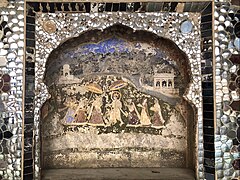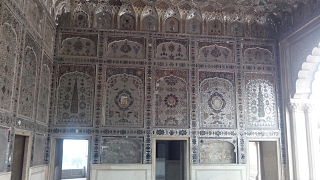Sheesh Mahal (Lahore Fort)
| Sheesh Mahal | |
|---|---|
شیش محل | |
 | |
 | |
| General information | |
| Type | Public monument |
| Architectural style | Mughal |
| Location | Lahore, Punjab
Pakistan |
| Coordinates | 31°35′23″N 74°18′47″E / 31.589827°N 74.313165°E |
| Construction started | 1631 |
| Completed | 1632 |
| Design and construction | |
| Architect(s) | Asif Khan |
The Sheesh Mahal (
imperial family and close aides. It is among the 21 monuments that were built by successive Mughal emperors inside Lahore Fort, and forms the "jewel in the Fort’s crown."[1] As part of the larger Lahore Fort Complex, it has been inscribed as a UNESCO World Heritage Site
since 1981.
Etymology

Sheesh Mahal, in Urdu language, literally means 'Crystal Palace'. However, with its pietra dura decorations[2] and intricate mirror-work inlaid into the white marble walls and ceilings creating gleaming effect,[3] the lavish room has come to be known as 'Palace of Mirrors', and sometimes the 'Hall of Mirrors'. Similar halls are also found in the contemporary palace of the Agra Fort, and show influence on the later additions to Amber Fort.
History

The solid
Moti Masjid, Naulakha Pavilion, sleeping chambers, and Sheesh Mahal in to the complex. Sheesh Mahal is located within the Shah Burj (King's Pavilion) block that was actually built by his predecessor Jahangir. The chamber was exclusively used for private council meetings as part of the daily routine of the emperor, whereas the whole block was only accessible to the imperial princes, the vizier, and selected courtiers.[5] The extension work of private quarters by Shah Jahan continued between 1628 and 1634. The distinctive Shah Jahani architecture is reflected in the extensive use of white marble and hierarchical accents of the construction.[6] During the Sikh Empire, Shah Burj became Ranjit Singh's favourite place. He built a harem over the top of Sheesh Mahal.[4] Kangra style frescoes were also added during his reign, and the original entrance to the Sheesh Mahal quadrangle was closed off and the Athdara built in its place. This was also the place where he used to display his prized possession, the Koh-i-Noor.[7]
Design


The Sheesh Mahal was built by Emperor Shah Jahan. It was built in the middle of Jahangir's rule. The
geometrical and tendril designs.[9] The roof of the central hall rises up to two storeys. The hall was originally decorated with fresco paintings that were later replaced with glass mosaic in different colours.[1]
Conservation

The additional constructions carried out during the subsequent
UNESCO World Heritage Site. It was not until 2006 that the problems of the ceiling were comprehensively resolved and the structure was restored.[11]
Gallery
-
A view of the Sheesh Mahal's façade
-
Close-up of Sikh era Kangra murals
-
The pillars used in the buildings were decorated with floral motifs
-
Sheesh Mahal's ceilings
-
Interior panorama view.
-
Another Sikh era Kangra mural of Hindu deities
-
Sheesh Mahal Garden
-
Inside Sheesh Mahal
-
Sheesh Mahal – Lahore Fort
See also
- Badshahi Mosque
- Shalimar Gardens
- Walled City of Lahore
- List of UNESCO World Heritage Sites in Pakistan
Notes
- ^ a b Khan, Shehar Bano (2004) Wither heritage? Dawn. 11 July. Retrieved 22 April 2008
- ^ Haider (1978)
- ^ Shish Mahal, Lahore. British Library. Asia, Pacific and Africa Collections. Retrieved 21 April 2008
- ^ a b Chaudhry (1998)
- ^ Koch (1997), p. 151
- ^ Koch (1991), p. 114
- ^ Lal (1876)
- ^ Lahore Fort Complex: Shish Mahal Archived 14 December 2010 at the Wayback Machine. Retrieved 21 April 2008
- ^ Dogar (1995)
- ^ Khan (1997)
- ^ Cultural week opens at Fort. Dawn. 16 August 2006. Retrieved 22 April 2008
References
- Asher, Catherine E G (1992) Architecture of Mughal India. ISBN 0-521-26728-5
- Chaudhry, Nazir Ahmed (1998) Lahore: Glimpses of a Glorious Heritage. Sang-e-Meel Publications. ISBN 969-35-0944-7
- Dogar, Muhammad Aasim (1995) Splendour of Lahore Fort. Ilm Dost Publishers.
- Haider, Zulqarnain (1978) Pietra Dura Decorations of Naulakha at Lahore Fort. (Mujallah-e-Taḥqĭq, Kullīyah-e-ʻUlūm-e-Islāmiyah va Adabiyāt-e-Sharqiyah). Faculty of Islamic and Oriental Learning University of the Punjab.
- Khan, Ahmed Nabi (1997) Studies in Islamic Archaeology of Pakistan. Sang-e-Meel Publications
- ISBN 3-7913-1070-4
- Koch, Ebba (1997) Mughal Palace Gardens from Babur to Shah Jahan (1526-1648). Muqarnas, Vol. 14, pp. 143–165. JSTOR 1523242
- Lal, Kanhaiya (1876). Rai Bahadur. Zafar Nzmah-i-Ranjit Singh, Ranjit Namah. Mustafaee Press. Lahore
External links
Wikimedia Commons has media related to Sheesh Mahal (Lahore Fort).


















